How to Design a Kitchen: Getting Cabinets Right
Remodeling a kitchen is expensive. For most people, it's a once or twice a lifetime thing, just because of the expense and massive disruption involved. So when you do it you want to do it in a way that will grow and change with your needs.
This need for growth is why I dislike very specific cabinets aimed at solving a problem you have right now (or a problem you don't have at all, but you're just in love with how clever the solution is). My starting place for a kitchen is: lots of drawers, and plain cabinets. There is one exception I make, but other than that none of this is about buying specialty cabinets.
In fact, some of these things I'm about to show you can be used in your current kitchen minus any kind of remodel. Many times the reasons for replacing cabinets are more complex than just not having good spaces to store things, but sometimes people feel frustrated and angry with their kitchen just because they're not using it all. This is how I used to talk myself out of kitchen remodel jobs (and into decluttering jobs).
Let's start with the only purpose-built cabinet I like: the pull out trash bins.
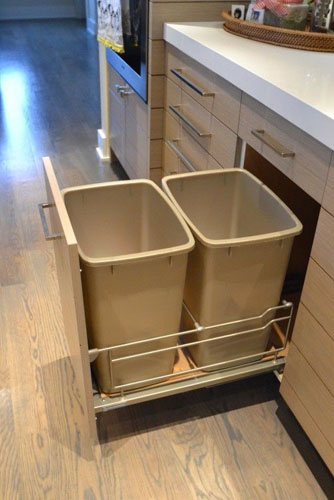
I used to be anti-trash bin cabinet. But we have them at work and they are pretty nice. The trash goes back into the cabinet and is out of the way. I like this kind, with a base for the trash bins to sit on. In this kind of cabinet, when there is a drawer above the trash I always add a "base drop barrier" which basically keeps things from the drawer from falling into the trash, but also keeps any smells from the trash from stinking up stuff in the drawer. I would still only keep things like trash bags and utility items in there.
The bad-idea version of this cabinet is here:
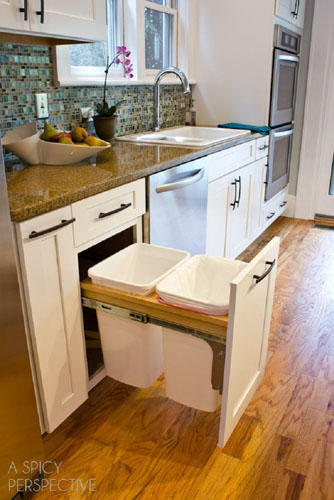
The peril of this cabinet is the combination of plastics failure and heavy trash can make a real mess, and that mess can get stuck inside the cabinet (if the failure happens when the drawer is closed). Also, if you can't find the right size replacement bins when they go bad, your trash drawer is suddenly useless.
And that is it. No other special cabinets. Everything else is either a drawer or a door cabinet. I generally prefer more drawers, because we have a big drawer cabinet in our kitchen now and it is the most useful thing ever.
So let me show you how to use those cabinets.
1. Hang things
These stemware hangers are readily available (this one is sold by Hafele, who make all kinds of cabinet accessories), or you can make them very easily, and they make storing stemware very easy.
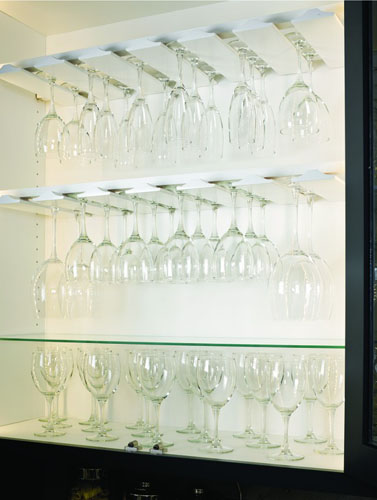
If you have very tall shelves, you can use more space by hanging stemware over shorter things. But even in a more open layout like this one, the stemware is more usable because dust doesn't collect in the bottoms of the glasses. We store all our glasses upside down (hi, we have two large dogs and like to make a mess in the house), and this is a little less wobbly for earthquake country.
2. Add pull-out shelves to make door cabinets into drawers
Sometimes a door cabinet makes a lot of sense. Either you like the look, or you just don't want to pay a ton of money for drawers (which are quite expensive). In that case, make a door cabinet more useful by adding pullouts.
Pullouts come in a million variations. The classic wood ones are great:
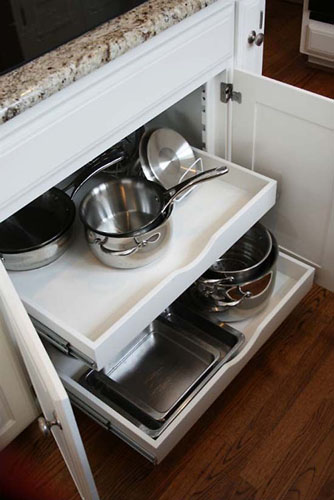
But you can also get them designed to hold specific kinds of things neatly:
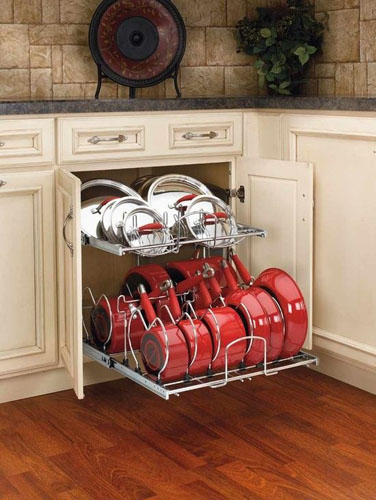
That organizer is flexible, too, so you can size it to fit the actual pans you have. You could definitely store those pans in that cabinet without the pullout organizer, but it would be a lot more work to get at any specific one of them.
3. Add accessories to make your space more usable
When you spend your money getting quality rather than gimmicks, you have money to spend to customize your cabinets. I recommend against having the cabinetmaker do this stuff because they will charge you a lot for it (most will admit that cabinet accessories are a high-profit area). Even paying somebody to install them is often not worth it, since any reasonably handy person can install accessories in a cabinet.
My current favourites are this undersink pullout organizer for cleaning supplies:
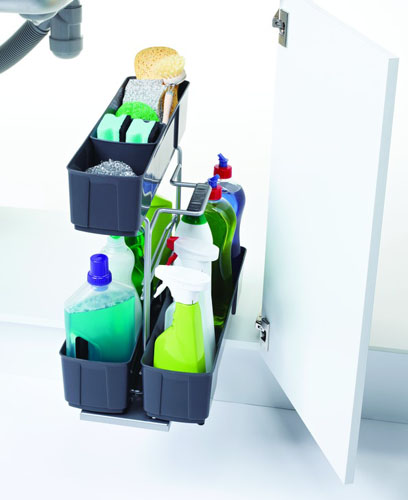
And also for under the sink, a pullout towel rack. My firm actually sells a whole 9 inch wide cabinet with a similar rack in it, which is madness. Screw this in under your kitchen sink and save yourself about $300. Now you deserve pizza for dinner as a reward for saving yourself so much money.

(I showed the schematic because a lot of people have a hard time seeing how the racks extend in the photos.)
4. Use dividers to make the most of large drawers
Big drawers are great for storing big things, and they are more versatile over time than smaller drawers sized to fit specific things. One way to harness that versatility is to use these peg organizer systems.
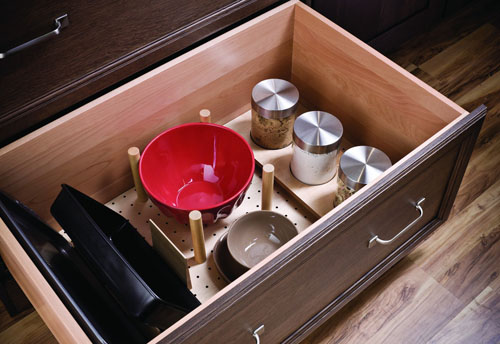
You can move the pegs around to change the configuration of the drawer, and they help keep stuff from sliding all over the place and turning into a disorganized mess.
5. You can put a smaller drawer in a too-large drawer
If a drawer has a lot of space on the top, you can also basically add another drawer on top. This can be a lift-out tray, or it can actually be an operating drawer:
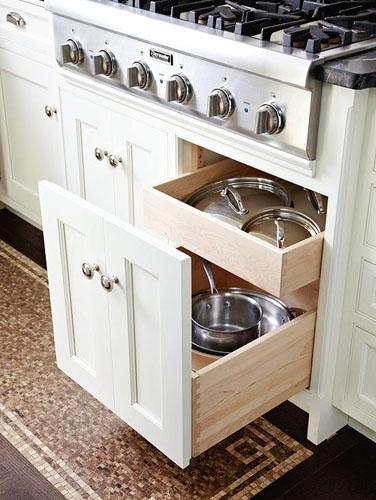
Then if you need the height, you can just remove that drawer and set it aside for the future, when your needs change again and you have a use for it.
6. You will not regret tray dividers
The one cabinet that was in our kitchen when we bought the house, that I love beyond all reason, is our tray cabinet.
You will never, ever regret having vertical slots to store trays, cutting boards, and cookie sheets. They come in a lot of varieties, from built-in:
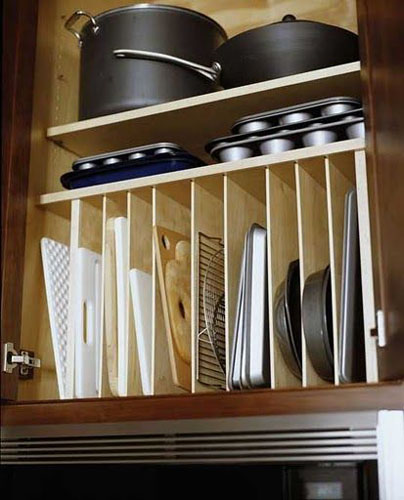
To a fairly simple divided pullout:
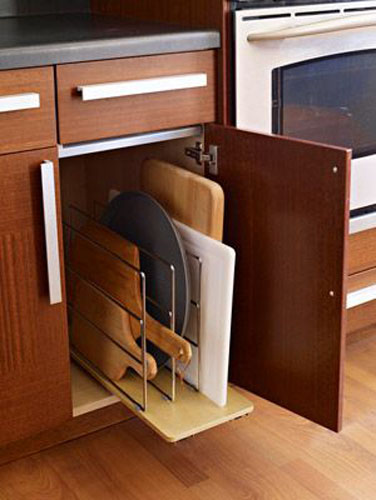
To a more complex pullout:
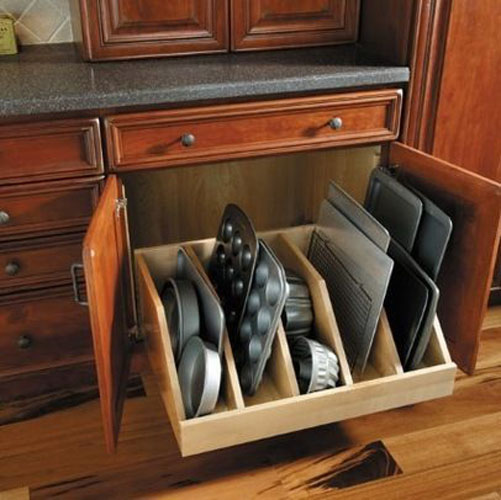
All of them are good, though you should look at your ratio of thinner items (sheet pans) to thicker ones (cupcake trays) to see what will work better for you. I personally don't feel any real need for tray dividers to pull out of the cabinet, but I can definitely see the appeal. There's also budget and aesthetics to consider. Pinterest is full of cheap ideas for making tray dividers if cost is an issue.
7. Don't build in drawer dividers
A common upgrade people like to make is to put in drawer dividers for silverware or utensils. I generally don't like that, because then you are stuck with those dividers forever. Plus, they are super hard to clean if your kid (or a drunken party guest) spills something in the drawer as will inevitably happen.
So what are your options?
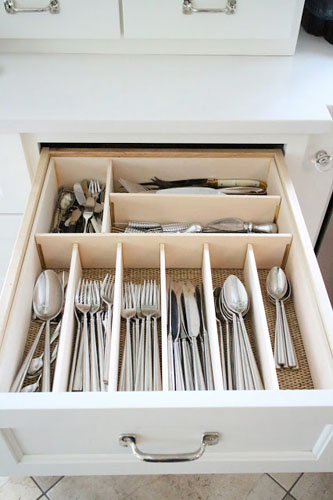
You can make custom-fitted dividers that look built in but can be removed. (The image above is the result of one approach to doing that.)
Pros: looks built-in, doesn't slide around, and can be modified or cleaned as needed
Cons: you must be able to use tools without killing yourself
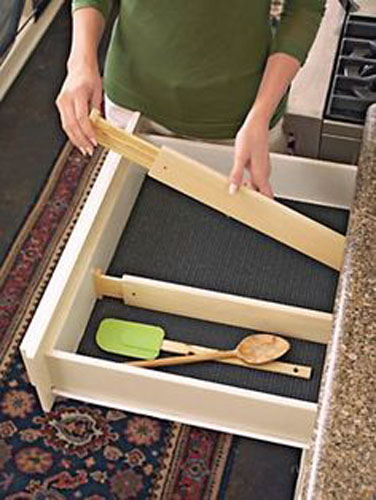
You can use adjustable dividers that pressure-fit into place.
Pros: adjustable, easily removed, easily replaced
Cons: they can be junky, they can only divide the drawer in very specific ways, if they aren't strong enough they can slide around
Or you can just use store-bought dividers that don't fit perfectly and be OK with it. (This is what I do. We use the gap around the dividers to store narrow things like disposable chopsticks or boxes of matches.) Or, if your budget is really low, just reuse small boxes or food containers to corral your stuff. When you have money later, you can upgrade to something fancier, but always make it removable so you can change the drawer configuration or even just clean the organizer.
So the advice is very simple: stick with the basics, trick out your cabinets by buying or making accessories, and don't buy any cabinet that is going to force you to live your 2015 life in 2030.
Coming up: The great upper cabinet debate.
posted by ayse on 08/20/15